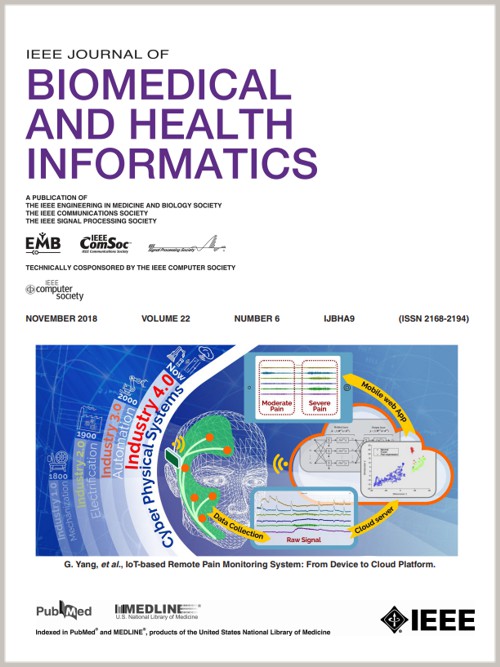高亮扩散模型作为息肉分割的插件先验模型
IF 6.7
2区 医学
Q1 COMPUTER SCIENCE, INFORMATION SYSTEMS
IEEE Journal of Biomedical and Health Informatics
Pub Date : 2024-10-24
DOI:10.1109/JBHI.2024.3485767
引用次数: 0
摘要
从结肠镜图像中自动分割息肉对诊断结肠直肠癌至关重要。然而,这种分割的准确性受到两个主要因素的挑战。首先,息肉的大小、形状和颜色各不相同,再加上由于需要专门的人工标注,因此缺乏标注准确的数据,这阻碍了现有深度学习方法的功效。其次,隐藏的息肉往往与邻近的肠道组织相融合,导致对比度差,给分割模型带来挑战。最近,人们探索并调整了用于息肉分割任务的扩散模型。然而,RGB 结肠镜图像与灰度分割掩模之间存在巨大的域差距,而且扩散生成过程的效率较低,这些都阻碍了这些模型的实际应用。为了缓解这些挑战,我们引入了高亮度扩散模型增强版(HDM+),这是一种两阶段息肉分割框架。该框架结合了高亮扩散模型(HDM),以提供明确的语义指导,从而提高分割的准确性。在初始阶段,HDM 使用突出显示的地面实况数据进行训练,在强调息肉区域的同时抑制图像中的背景。这种方法通过关注图像本身而不是分割掩膜来减少领域差距。在随后的第二阶段,我们利用经过训练的 HDM U-Net 模型中的高亮特征作为息肉分割的插件先验,而不是生成高亮图像,从而提高了效率。在六个息肉分割基准上进行的广泛实验证明了我们方法的有效性。本文章由计算机程序翻译,如有差异,请以英文原文为准。
Highlighted Diffusion Model as Plug-In Priors for Polyp Segmentation
Automated polyp segmentation from colonoscopy images is crucial for colorectal cancer diagnosis. The accuracy of such segmentation, however, is challenged by two main factors. First, the variability in polyps' size, shape, and color, coupled with the scarcity of well-annotated data due to the need for specialized manual annotation, hampers the efficacy of existing deep learning methods. Second, concealed polyps often blend with adjacent intestinal tissues, leading to poor contrast that challenges segmentation models. Recently, diffusion models have been explored and adapted for polyp segmentation tasks. However, the significant domain gap between RGB-colonoscopy images and grayscale segmentation masks, along with the low efficiency of the diffusion generation process, hinders the practical implementation of these models. To mitigate these challenges, we introduce the Highlighted Diffusion Model Plus (HDM+), a two-stage polyp segmentation framework. This framework incorporates the Highlighted Diffusion Model (HDM) to provide explicit semantic guidance, thereby enhancing segmentation accuracy. In the initial stage, the HDM is trained using highlighted ground-truth data, which emphasizes polyp regions while suppressing the background in the images. This approach reduces the domain gap by focusing on the image itself rather than on the segmentation mask. In the subsequent second stage, we employ the highlighted features from the trained HDM's U-Net model as plug-in priors for polyp segmentation, rather than generating highlighted images, thereby increasing efficiency. Extensive experiments conducted on six polyp segmentation benchmarks demonstrate the effectiveness of our approach.
求助全文
通过发布文献求助,成功后即可免费获取论文全文。
去求助
来源期刊

IEEE Journal of Biomedical and Health Informatics
COMPUTER SCIENCE, INFORMATION SYSTEMS-COMPUTER SCIENCE, INTERDISCIPLINARY APPLICATIONS
CiteScore
13.60
自引率
6.50%
发文量
1151
期刊介绍:
IEEE Journal of Biomedical and Health Informatics publishes original papers presenting recent advances where information and communication technologies intersect with health, healthcare, life sciences, and biomedicine. Topics include acquisition, transmission, storage, retrieval, management, and analysis of biomedical and health information. The journal covers applications of information technologies in healthcare, patient monitoring, preventive care, early disease diagnosis, therapy discovery, and personalized treatment protocols. It explores electronic medical and health records, clinical information systems, decision support systems, medical and biological imaging informatics, wearable systems, body area/sensor networks, and more. Integration-related topics like interoperability, evidence-based medicine, and secure patient data are also addressed.
 求助内容:
求助内容: 应助结果提醒方式:
应助结果提醒方式:


